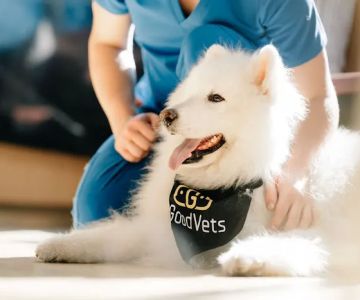How to Handle a Pet with Food Allergies
Having a pet with food allergies can be a bit overwhelming, especially if you're not sure what’s causing their discomfort. When my dog first began experiencing skin irritations and digestive issues, I was at a loss. After a trip to the vet and some research, I realized that food allergies were likely the culprit. Since then, I’ve learned a lot about how to handle this situation, and now I want to share what I’ve discovered so that you can help your pet feel better too.
1. Understanding Pet Food Allergies
Before diving into how to treat food allergies, it’s important to understand what they actually are. A food allergy occurs when your pet’s immune system mistakenly identifies a specific food ingredient as harmful. This triggers an immune response, causing a range of symptoms. It’s important to note that food intolerances are different from allergies, though the symptoms can be similar. In food allergies, the immune system is involved, while in food intolerances, it’s a digestive issue.
1.1 Common Symptoms of Food Allergies in Pets
The symptoms of food allergies in pets can vary, and they are often the first clue that something’s wrong. In my experience, my dog’s allergies manifested as frequent ear infections, itchy skin, and upset stomachs. Other common signs include vomiting, diarrhea, and bloating. If your pet is displaying any of these symptoms, it’s essential to consult with your veterinarian to determine the cause.
1.2 Common Triggers of Food Allergies in Pets
Certain ingredients are more likely to trigger food allergies in pets. For dogs, common allergens include beef, chicken, dairy, wheat, and soy. Cats can also have food allergies, and common triggers for them include fish, dairy, and chicken. In my case, after a process of elimination and vet tests, we discovered that my dog was allergic to wheat and beef. Identifying the specific allergen can often take time, but it’s an essential part of managing your pet’s health.
2. How to Diagnose Food Allergies in Pets
Diagnosing food allergies in pets isn’t always straightforward. Your veterinarian will likely start with a thorough physical exam and a detailed history of your pet’s symptoms. To pinpoint the exact allergen, your vet may recommend an elimination diet, where you feed your pet a novel protein (such as lamb or duck) and a carbohydrate source that they’ve never eaten before. This process helps rule out common allergens and can take several weeks to get definitive results.
2.1 Elimination Diets
An elimination diet involves removing all potential allergens from your pet’s diet and feeding them only a special hypoallergenic food. This allows you to track any changes in symptoms and gradually reintroduce foods to identify the culprit. It’s a slow process, but it’s one of the most effective ways to find out which food is causing the problem. In my case, switching to a hypoallergenic food and carefully monitoring my dog’s reactions helped us find the right solution.
2.2 Allergy Testing
Some veterinarians may recommend allergy testing, which can either be a blood test or a skin test, to help identify allergens. While this can provide more immediate answers, it’s not always conclusive when it comes to food allergies, and some pets may have a negative reaction to multiple foods. For this reason, an elimination diet is usually the gold standard for diagnosing food allergies.
3. Choosing the Right Food for Your Pet
Once you’ve identified your pet’s food allergies, the next step is choosing the right food. This is crucial because continuing to feed your pet the wrong food can lead to chronic symptoms and long-term health issues. There are many options available, including prescription diets, hypoallergenic dog foods, and homemade diets. Here’s what I’ve learned along the way:
3.1 Prescription Diets for Food Allergies
Many veterinarians recommend prescription diets specifically formulated for pets with food allergies. These foods contain limited ingredients, making it easier to identify which ones are safe for your pet. Some prescription foods are also hydrolyzed, meaning the protein has been broken down into smaller particles, which can help reduce allergic reactions. This was the route I took for my dog, and it made a noticeable difference in his skin and digestive health.
3.2 Hypoallergenic Pet Foods
If you prefer not to use prescription foods, hypoallergenic pet foods are a good alternative. These foods are designed to be gentle on the stomach and often include novel proteins and carbohydrates that pets haven’t been exposed to. Many brands offer options that are free from common allergens, such as grain-free or dairy-free foods. My dog’s allergies improved dramatically after switching to a grain-free food, and I noticed a decrease in his digestive problems.
3.3 Homemade Diets
In some cases, making your pet’s food at home can be the best way to control exactly what they eat. With guidance from a veterinary nutritionist, you can create a balanced homemade diet tailored to your pet’s specific needs. This route requires careful planning and knowledge of pet nutrition, but it’s an option worth considering if you’re committed to ensuring your pet’s health and avoiding allergens.
4. Treating and Managing Your Pet’s Food Allergies
Once you've switched your pet to the right food, it’s important to maintain a consistent routine and avoid introducing any new foods that might trigger an allergic reaction. In addition to managing their diet, you may also need to treat any ongoing symptoms, such as itchy skin or ear infections, caused by the allergies.
4.1 Skin Irritations and Infections
If your pet is suffering from skin issues due to food allergies, your veterinarian may recommend topical treatments like soothing shampoos or anti-inflammatory creams. My dog experienced frequent ear infections due to his allergies, and we used a prescribed ear cleaner to help with the symptoms. Keeping your pet’s skin and ears clean and dry can also help prevent secondary infections from developing.
4.2 Supplements and Probiotics
Supplements and probiotics can also play a role in managing food allergies. Omega-3 fatty acids can help reduce inflammation and promote healthy skin, while probiotics can improve gut health and digestion. I incorporated an omega-3 supplement into my dog’s diet, which helped improve his skin and coat health.
5. Monitoring Your Pet’s Progress
After starting a new food regimen, it’s important to regularly monitor your pet’s health and behavior. Keep track of any changes in their skin, coat, or digestive system. If symptoms persist or worsen, contact your veterinarian for further advice. My dog’s symptoms gradually improved over several weeks, but it took a little time before I noticed significant changes.
5.1 Keeping a Food Allergy Journal
One helpful tip I’ve found is to keep a food allergy journal. By tracking what your pet eats and any symptoms they experience, you can more easily identify patterns and make adjustments as necessary. This journal helped me and my vet pinpoint exactly which foods triggered my dog’s allergies and which foods were safe for him.











